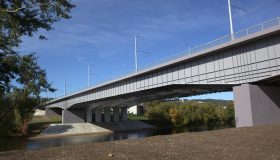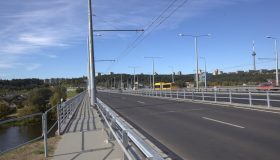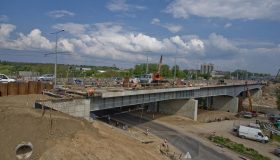
Reconstruction of the Lazdynai Bridge in Vilnius (the Link of the Trans-European Network- Stage IA of the Vilnius Western bypass)
Start date: 2008 November
End date: 2010 October
Value: 30,9 million euros without VAT
During reconstruction the bridge was widened up to eight traffic lanes and integrated into the network of western and eastern access street network. Engineering networks, lighting and a trolleybus contact line were also reconstructed; Oslo St. was reconstructed between the Lazdynai Bridge and Erfurto St., and the viaduct across Oslo St. – Laisvės Ave. was renovated.
The Lazdynai Bridge is part of the Vilnius Western bypass therefore the commencement of construction of the bypass and increased traffic flows across the bridge, which was built in 1979, prompted the need for bridge repairs.
During reconstruction the former six-lane bridge was widened up to eight lanes – the bridge was widened by 11.25 m and is currently 39-metres wide and 233-metres long. The new lanes are used by traffic coming from Laisvės Avenue. During the works the external rests of the old part of the bridge were strengthened, the finishing works were performed to the bridge and its accesses.
This is one of the most complicated transport infrastructure objects in the city from an engineering point of view. New technologies were used for its construction. When building bridges, beams are usually pushed from one side of the river. In this case another solution has been selected – to push beams from both sides of the Neris banks with the help of double-acting hydraulic cylinders.
Since the beams weighed as much as 400 tonnes the so-called special slides were made. With the help of those slides the welded part of the bridge was pushed towards the other bank of the river. A beam could only be moved 3 metres per hour, therefore, the works took a number of months.
The welding of metal structures of the bridge up to 20-metres in length required much effort too. Welding works were carried out in special sites installed at a height of 8 metres above the river.
After the pushing of beams was finished and their ends were assembled, they were connected with two-metre long connecting beams. Then it was necessary to weld the beams on the left and the right banks of the river, to lift up the bridge itself a little, and to dismount the slides.
The bridge was then lowered into the design position on the already constructed bearings and the final beams were installed. Afterwards, the bridge deck slabs were laid, the pavement was renewed and lighting and contact networks were installed.
The renewed bridge could be said to have broken all previous records; the distance between the columns raised on the different banks of the river comes to 100 metres – the longest of all metal bridges in our country.



